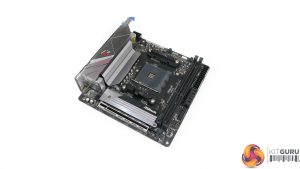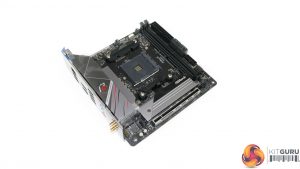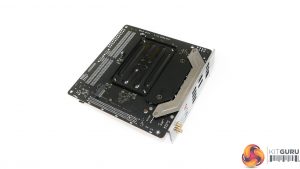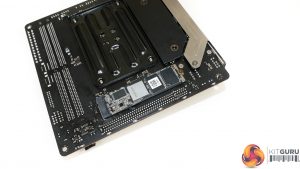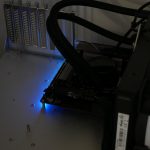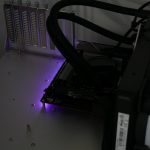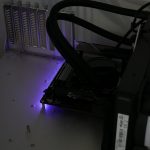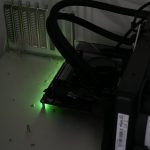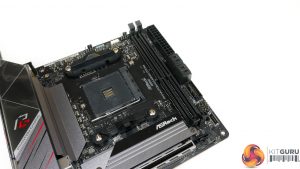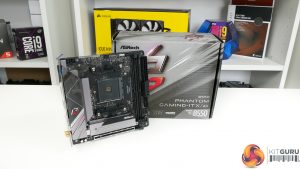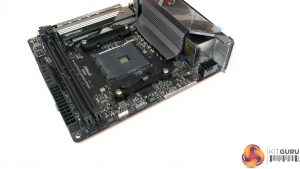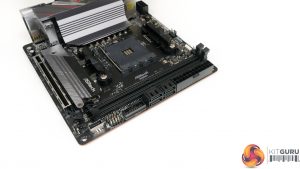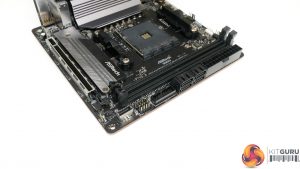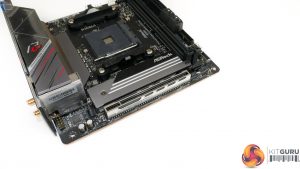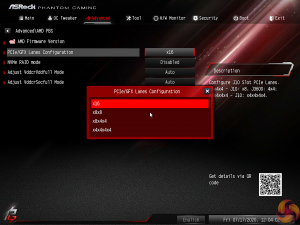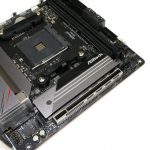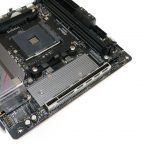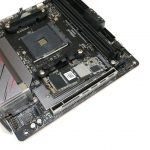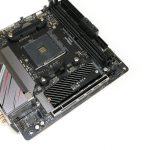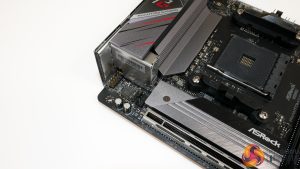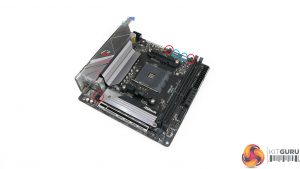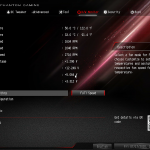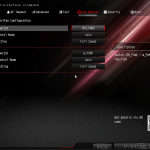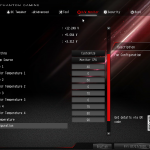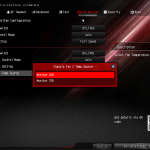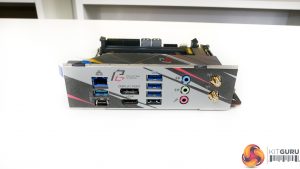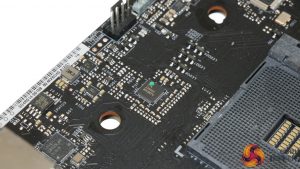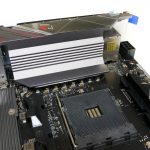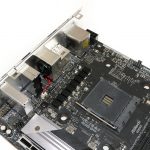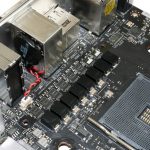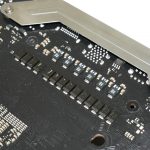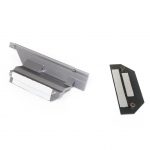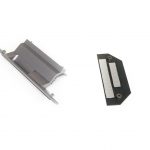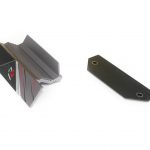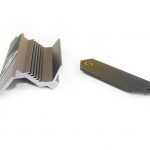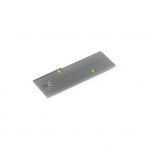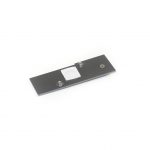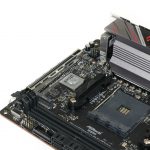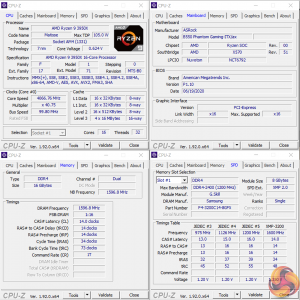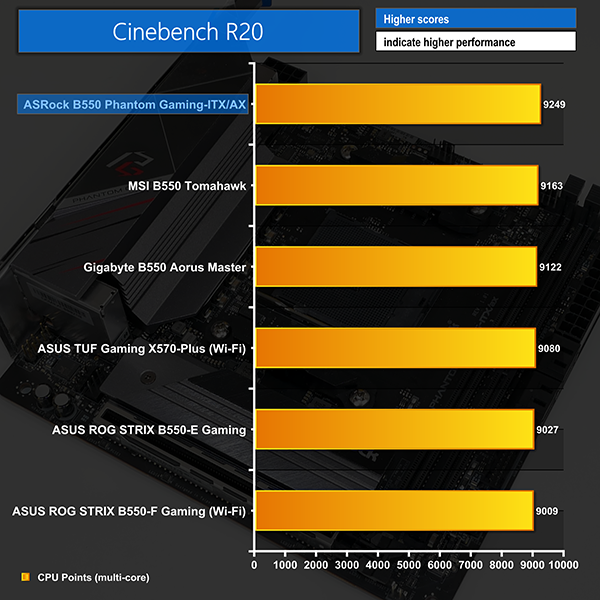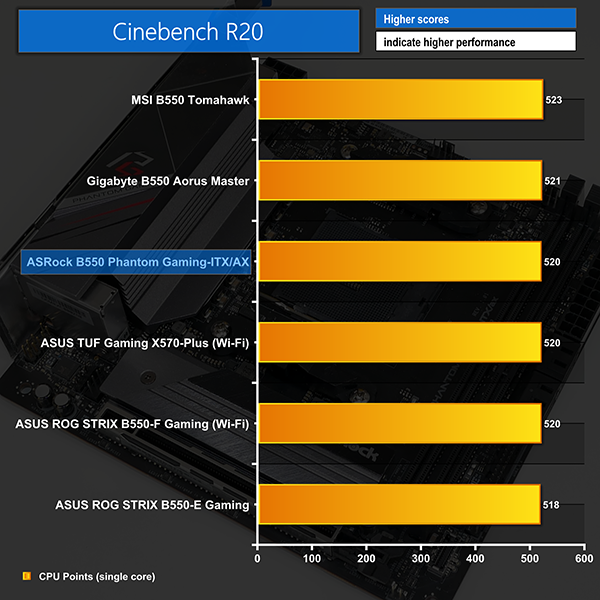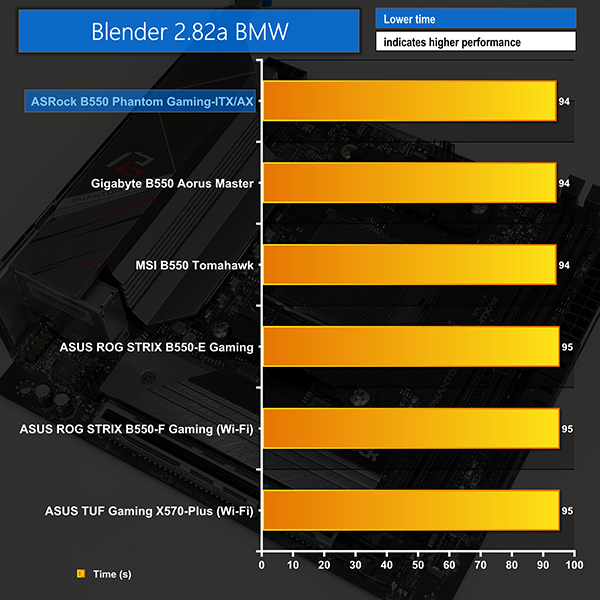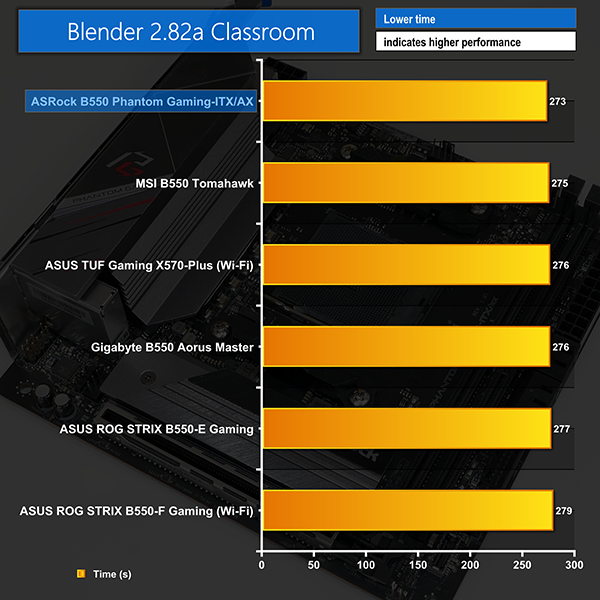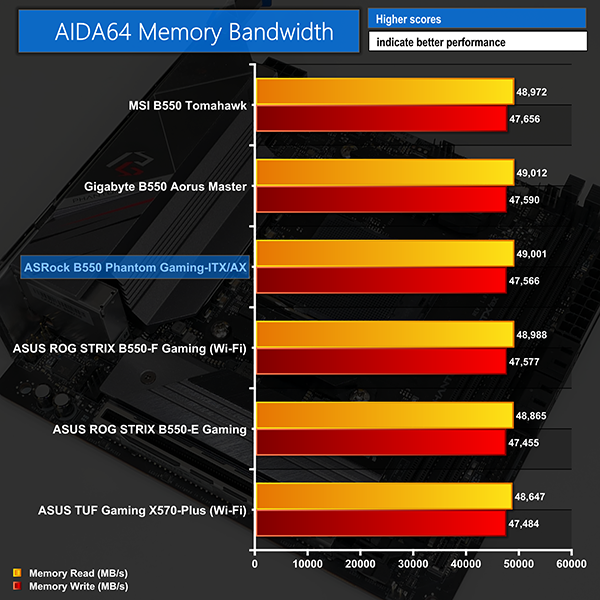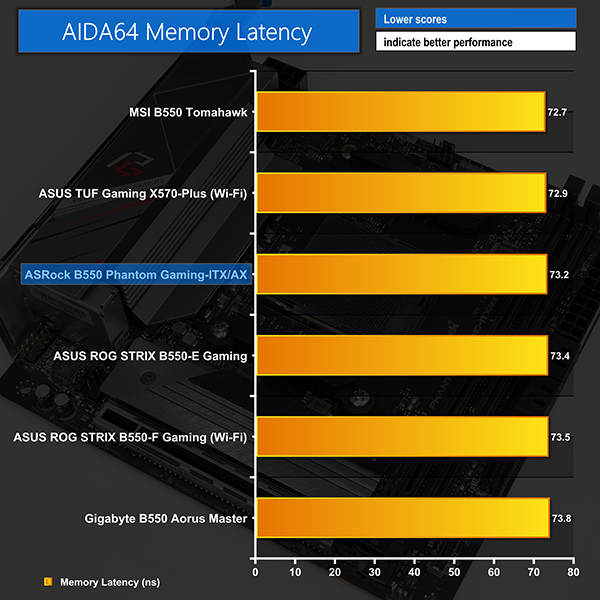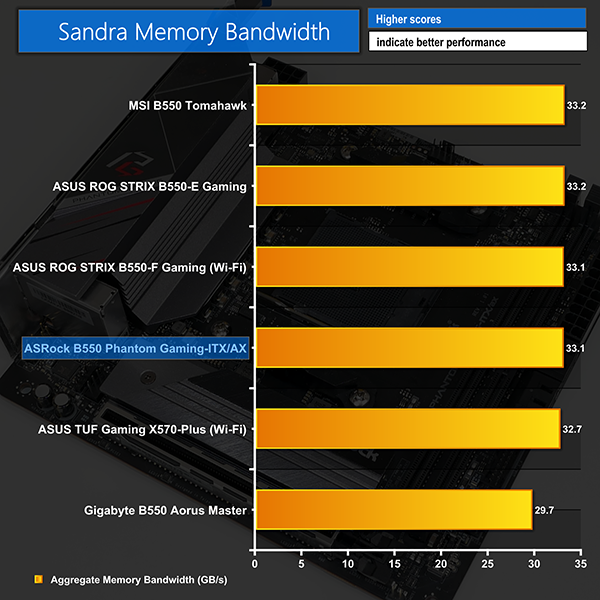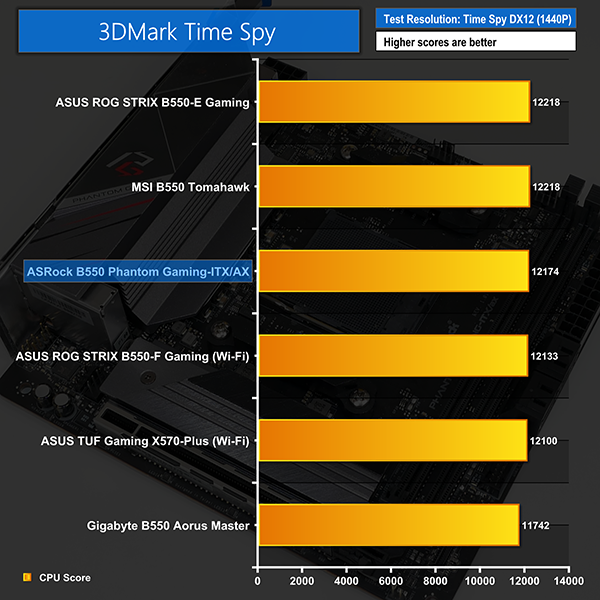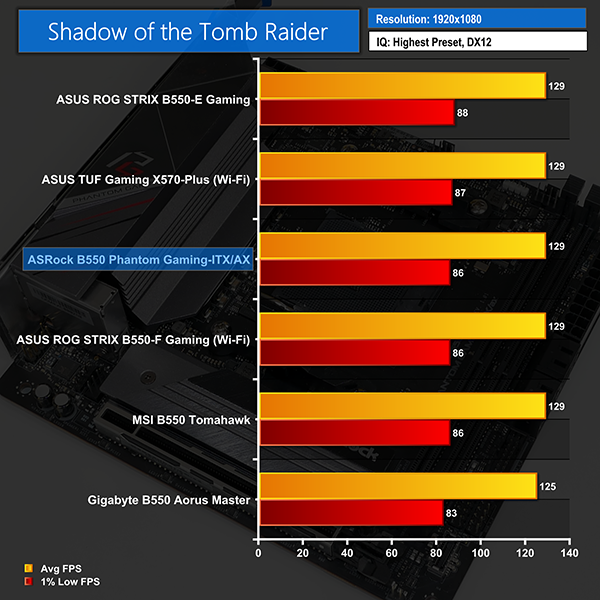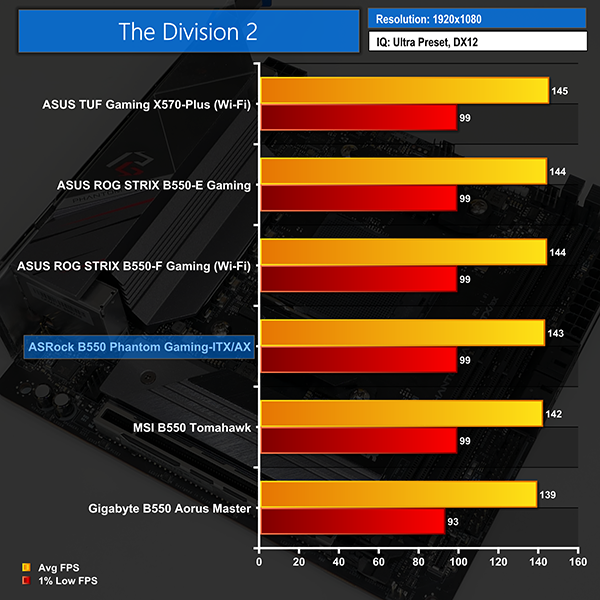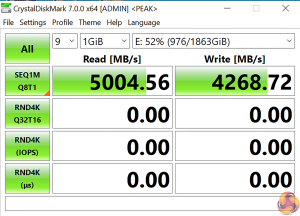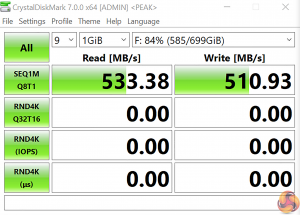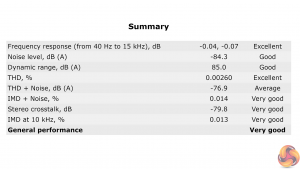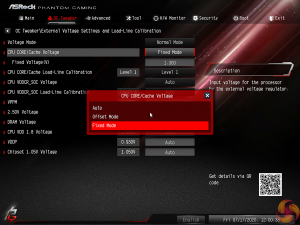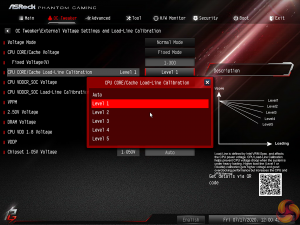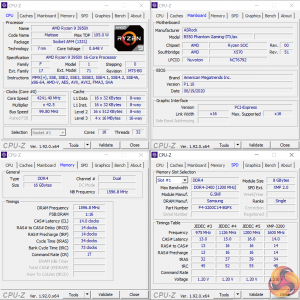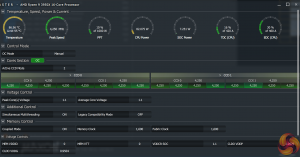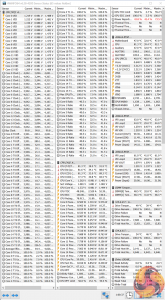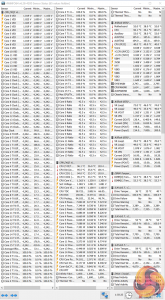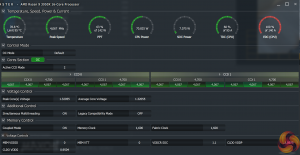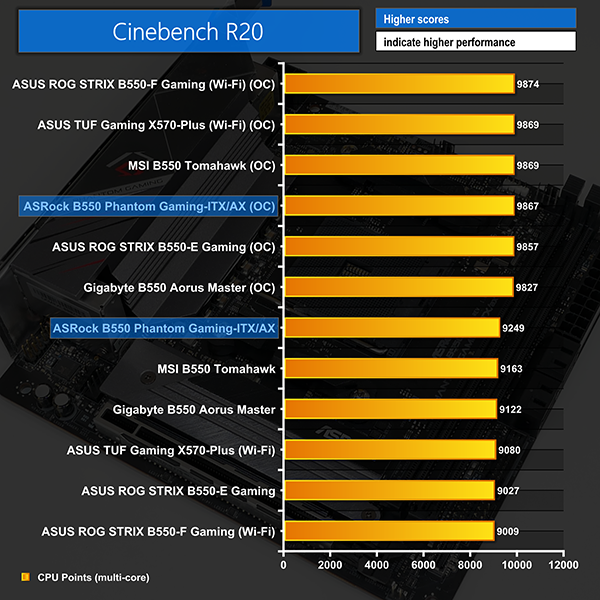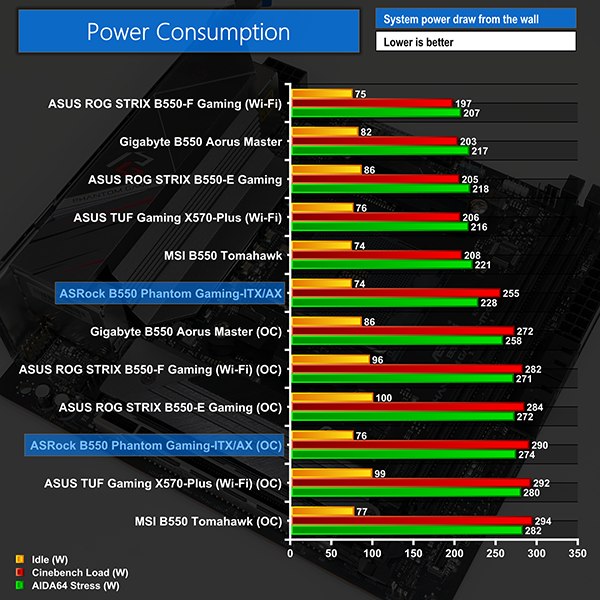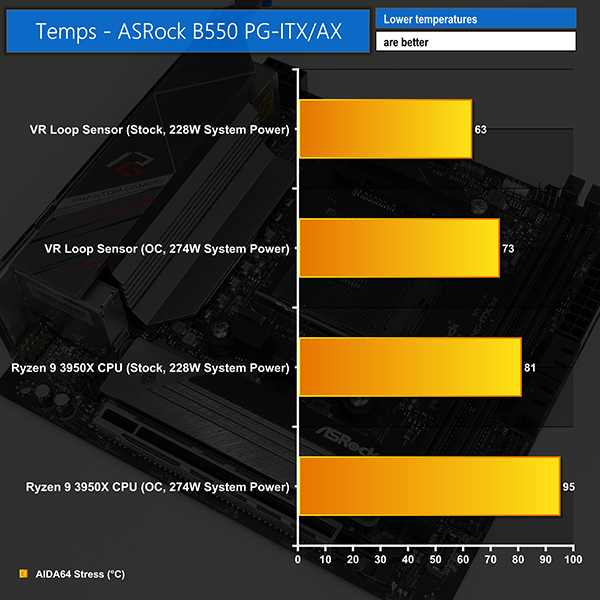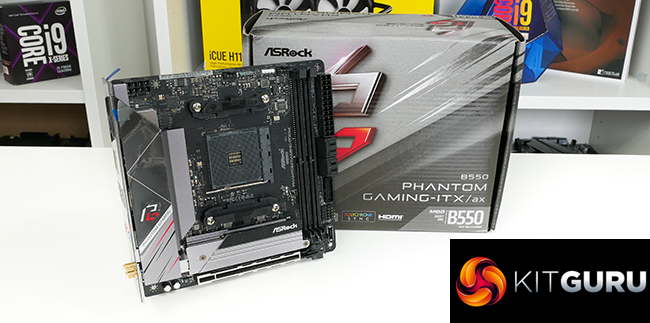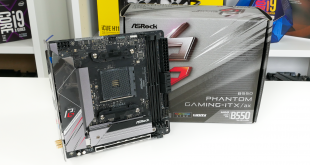
B550 and mini-ITX can go hand-in-hand for AM4 buyers, so does the ASRock B550 Phantom Gaming-ITX/AX provide the necessary feature set and performance to make it a desirable option? The 8-phase power delivery solution, 8-layer PCB, and ample high-speed connectivity paint a positive picture, but let’s take a closer look.
Core to the ASRock B550 Phantom Gaming-ITX/AX is its passively cooled power delivery system. Built around an eight-phase solution, ASRock deploys six 90A DrMOS power stages for the CPU VCore portion specifically.
Added to the package are dual M.2 connectors, one of which runs with Gen 4 lanes and a cooling heatspreader. You also get 2.5 GbE from an Intel adapter and 802.11ax WiFi connectivity.
ASRock clearly ticks the main boxes with the B550 Phantom Gaming-ITX/AX, so let’s take a closer look at the motherboard itself.
Features (information taken from the ASRock webpage):
-
- Supports 3rd Gen AMD AM4 Ryzen™ / Future AMD Ryzen™ Processors
- 8 Power Phase Design, Digi Power, 90A Dr.MOS
- Supports DDR4 5400+ (OC)
- 1 PCIe 4.0 x16
- Graphics Output Options: HDMI, DisplayPort
- 7.1 CH HD Audio (Realtek ALC1220 Audio Codec), Nahimic Audio
- 4 SATA3, 1 Hyper M.2 (PCIe Gen4 x4), 1 Ultra M.2 (PCIe Gen3 x4 & SATA3)
- 3 USB 3.2 Gen2 (Rear Type A+C, Front Type-C), 6 USB 3.2 Gen1 (2 Front, 4 Rear)
- Intel® 2.5G LAN, Wi-Fi 6 802.11ax (2.4Gbps) + BT 5.1
The ASRock B550 Phantom Gaming-ITX/AX motherboard uses the usual design for ASRock’s Phantom Gaming styling; you get lots of black and grey with touches of red.
A partial rear IO shroud cover is a solid premium touch, and it is metal and joined with the VRM heatsink. There are no large vertical interferences or daughter boards – the overall design is very good from a perspective of minimising height and vertical interference
ASRock positions a solid cooling plate on the rear side of the MOSFET area. This is used to sap heat away from the PCB and perhaps the flat capacitors. An 8-layer PCB is used for the motherboard.
The rear, un-cooled M.2 slot runs at PCIe Gen 3×4 from the B550 chipset. There is very little room for a cooled M.2 SSD even with a thin heatsink like the WD_Black SN750. As such, this location should be reserved for drives with less demanding lifespans, such as an OS drive or a slower SSD with fewer write intensive workloads.
A row of LEDs is mounted directly on the underside of the PCB and provides a subtle RGB glow to the bottom of the motherboard.
Two single latch DIMM slots provide support for up to 64GB of DDR4 memory. ASRock quotes speed compatibility of more than 5000MHz via overclocking, but this will be heavily influenced by BIOS and CPU IMC capability.
Spacing between the RAM slots and the CPU socket is reasonable for cooler support. Even AIO coolers with tubing exiting the side of the pump block unit are unlikely to cause major interference headaches.
The standard AM4 CPU socket with standard AM4 mounting brackets is used for the B550 Phantom Gaming-ITX/AX. This is a notable change from the arguably more inconvenient LGA 115X mounting holes that ASRock decided to use with the X570 Phantom Gaming-ITX/TB3.
As unusual a point it is to highlight, the mounting brackets are good because they are the block style of manufacture rather than the smooth curved style used on some competing vendors. This has better bite on the mounting hardware for our Fractal and Corsair AIO coolers and makes it easier to install said AIO pump block units correctly.
There is also plenty of clearance around all sides of the CPU socket for reasonably sized air coolers or AIOs with large blocks.
A single 8-pin power connector is nestled nicely in the top-left corner with good accessibility. The power delivered by a single 8-pin is highly likely to be fine for AM4 in mini-ITX form.
Two 4-pin fan headers and two RGB headers are mounted along the top edge with great positioning. The board's overall upper area is very open and clear of potential interference points. This helps to minimise the likelihood of interference with thick cables or chassis fans in a cramped ITX chassis.
Mounting the 24-pin in the top right is fine in terms of accessibility.
Four right-angled SATA connectors are mounted on the motherboard, all of which operate from the B550 chipset. There is no bandwidth sharing between the SATA ports and other onboard hardware.
The SATA ports' right-angled mount is highly likely to cause interference in some cases, but it also allows ASRock to squeeze four ports into less PCB area. I would argue that two right-angled ports and two vertical ports would have been a better mounting solution. This would permit the right-angled connectors for cable management benefits and the outwards facing pair for omitting any interference potential.
A single outward facing 5Gbps USB header is located in an ideal location on the motherboard edge. Next door to this connector is the set of front panel headers and also a single USB 2.0 header. Just the single USB 2.0 header is annoying for users who have peripherals such as an AIO cooler plus RGB hardware, but the single header is common for ITX boards given the space constraints.
An internal 10Gbps USB Type-C front panel header is ideal and is mounted in a smart location. It is highly positive to see ASRock deploying a proper 10Gbps USB 3.2 Gen 2 connection to this header, as opposed to the watered down 5Gbps link seen on some competing motherboards.
The clear CMOS header is in the bottom right location, but this will be covered by a graphics card in a system build. ASRock's location decision for this header is not smart, especially given that it is the only clear CMOS connection for the motherboard.
ASRock gives the single full-length expansion slot the steel reinforcement treatment. This slot runs at 16 lanes of PCIe Gen 4 bandwidth with a compatible CPU or Gen 3 bandwidth with a Renoir APU, according to the manual.
I see no interference concerns around the single expansion slot, even for graphics cards with sizable backplates
In the UEFI, there is a setting that allows a user to control the bifurcation of this PCIe x16 slot. The options for bifurcation within the UEFI are x16, x8/x8, x8/x4/x4, x4/x4/x4/x4.
This is ideal for users who want a break-out adapter cable to use an x8 graphics card as well as a high bandwidth add-on device.
The front mounted M.2 connector is rated for PCIe Gen 4 x4 from a compatible Ryzen CPU. ASRock uses a thin metal heatsink with a thermal pad to make direct contact with the front side of an installed M.2 SSD. The heatsink is slim and light but looks fit for purpose.
ASRock's chosen M.2 deployment method makes an SSD very easy to install as there is no messing around with daughterboards or full cover plates.
Beneath the M.2 area is another heatsink that is mounted directly to the motherboard PCB. This is used to cool the B550 chipset beneath. As B550 does not kick out much heat, I have no concerns about the chipset heatsink’s close proximity to a potentially hot M.2 device.
ASRock’s audio system is built around the popular Realtek ALC1220 audio codec. You get dedicated ELNA audio capacitors and an isolated PCB route for the left and right audio channels.
Also down in the bottom left area are headers for HD audio, a diagnostic speaker, and an additional 4-pin fan.
Three 4-pin fan headers are spaced around the motherboard and managed by a Nuvoton NCT5562D SuperIO controller. All three of the headers are within easy reach of the CPU socket. Two are allocated for CPU duties, the second of which can be switched easily to water pump duties. The third connector is for a chassis fan or water pump.
The CPU dedicated header can do up to 1A current output at 12V, while the other two headers that can power a fan or a water pump can do 2A at 12V for 24W of delivery.
Two RGB headers are mounted on the motherboard's top edge. One of the headers is a 3-pin addressable style and the other is 4-pin 12V.
Fan control capabilities through the UEFI are OK, but nothing more than just ‘OK‘.
You get a good number of intervals for manual fan speed curves. And ASRock supports a zero fan speed mode, if your fans can do it. However, the clear lack of hysteresis control is disappointing and needs adding in, as MSI and Gigabyte have done with their fan control systems.
There is also very limited temperature sensor input allocated to a user; one can only drive fan speed curves based on CPU or M/B temperature sensors whereas Gigabyte in particular gives a far greater range of sensor inputs.
The B550 Phantom Gaming-ITX/AX motherboard's rear IO is reasonable by ITX standards.
Notably, there are six USB ports, four of which are 5Gbps Type-A connections, with the other two being 10Gbps USB 3.2 Gen 2, one of which is in the Type-C format.
Networking is delivered by a 2.5GbE Intel I225-V chipset, while 802.11AX WiFi with Bluetooth 5.1 is also provided by an Intel adapter.
The board's audio outputs are very basic and the lack of optical SPDIF may disappoint some users, including myself. However, it is clear that optical SPDIF is becoming increasingly less common or useful in modern systems as HDMI and Displayport continue to prove popular for single-cable video and audio passthrough.
I am very pleased to see dual video outputs for high resolution capability. Displayport 1.4 can technically do 5K 120Hz according to ASRock specs, and the HDMI 2.1 port can do 4K60. ASRock also notes that the motherboard supports dual display output usage with an appropriate APU.
There are two clear areas of disappointment for the rear IO. One is the complete lack of a rear clear CMOS button. This is a truly annoying design decision that ASRock has made. The other glaring annoyance is the omission of BIOS flashback capability.
ASRock deploys a 6+2 stage power delivery solution that is managed by a Renesas 229004 PWM controller. The operating mode for this 6+2-phase configuration is in true 6+2 phase mode without phase doublers.
Six Intersil ISL99390 90A Smart Power Stages are used for the CPU VCore. These are superb power stages with a 90A continuous current delivery rating. Up to 540A rated theoretical current output capability for the CPU VCore is both impressive and ample for an AM4 Mini-ITX motherboard. The Intersil DrMOS power stages are some of the highest spec units on the market and are an absolutely superb choice for a six-phase B550 motherboard.
Two Intersil ISL99227 power stages are deployed for the SoC. These units are 60A rated and should deliver plenty of current for non-CPU components that demand power.
Eight total alloy chokes are mounted on the front side and work in coordination with the banks of flat capacitors mounted on the board's rear side. Six ‘100 C03‘ marked capacitors are allocated for the primary 6-phase CPU VRM. There is also a 10+4 bank of ‘470 02HQA‘ marked capacitors. ASRock advertises the motherboard as utilising 12k-rated Nichicon capacitors.
The primary VRM heatsink cools the front side power stages and also contacts the eight chokes. ASRock advertises this heatsink as an ‘XXL Aluminium Alloy Heatsink‘, which is nonsense because it is not ‘XXL'.
The (not) ‘XXL' heatsink is L-shaped for the main cooling body and is actually far smaller than I would have liked. Minimal effort has been made to design a proper heatsink and there is also a lack of effort applied to cramming fins into the confined space that ASRock has to work with. This does not look like a particularly well designed or effective heatsink, but it does have decent in-line surface area that should be OK for catching airflow from an appropriately orientated fan.
Speaking of fans, the complete lack of VRM cooling fan is a big positive factor, in my opinion. That is especially true in the B550 Phantom Gaming-ITX/AX's case whereby the underlying power stages are so efficient and high capacity that significant cooling is unlikely to be a necessity.
The rear side heatsink for the capacitors adds cooling capacity by distributing the VRM location heat over this plate’s area. It is more of a heatspreader than a heatsink, given its low profile and minimal surface area design. Two thermal pads make proper contact with all of the capacitors, so ASRock has clearly made an effort to allow this heatspreader to remove excess thermal energy from the vicinity.
A small metal strip chipset heatsink sits beneath the M.2 slot. The size of this miniature metal strip seems fine as the B550 chipset does not require a large amount of cooling capacity, unlike X570 silicon.
For more details on ASRock’s UEFI and OS software offering, check out our previous ASRock AM4 motherboard reviews HERE and HERE.
We will be outlining the ASRock B550 Phantom Gaming-ITX/AX motherboard’s performance with the AMD Ryzen 9 3950X CPU, 16GB of 3200MHz DDR4 memory, and an Aorus RTX 2080 Ti graphics card.
AM4 Motherboard Test System:
- Processor: AMD Ryzen 9 3950X.
- Memory: 16GB (2x8GB) G.SKILL 3200MHz CL14 DDR4 @ 1.35V.
- Graphics Card: Gigabyte Aorus RTX 2080 Ti XTREME (custom fan curve to minimise thermal throttling).
- System Drive: WD_Black SN750 PCIe 3.0 x4 NVMe M.2 SSD.
- Games and Test SSD: Crucial MX300 750GB & Aorus 2TB PCIe Gen 4 M.2 SSD.
- CPU Cooler: Fractal Celsius+ S28 Prisma 280mm AIO (full speed fans and pump to eliminate thermal throttling).
- Power Supply: Seasonic Prime TX-1000 1000W.
- Case: Lian Li Open-air Test Bench.
- Operating System: Windows 10 Pro 64-bit.
BIOS Version:
- BIOS version 1.10 (AGESA ComboAM4v2PI 1.0.0.2) [Latest at the time of testing]
Comparison Motherboards:
- ASUS ROG STRIX B550-E Gaming (AGESA 1.0.0.1)
- ASUS ROG STRIX B550-F Gaming (WiFi) (AGESA 1.0.0.1)
- Gigabyte B550 Aorus Master (AGESA ComboAM4v2 PI 1.0.0.1)
- MSI MAG B550 Tomahawk (AGESA ComboAM4v2PI 1.0.0.2)
- ASUS TUF Gaming X570-Plus (Wi-Fi) (AGESA Combo-AM4 1.0.0.4)
Tests:
- Cinebench R20 – All-core & single-core CPU benchmark (CPU)
- Blender 2.82a – All-core rendering of the BMW and Classroom benchmarks (CPU)
- SiSoft Sandra – Memory bandwidth (Memory)
- AIDA64 – Memory bandwidth, memory latency (Memory)
- 3DMark TimeSpy – Time Spy (1440p) test (Gaming)
- Shadow of the Tomb Raider – 1920 x 1080, Highest quality preset, no AA, DX12 version (Gaming)
- Tom Clancy's The Division 2 – 1920 x 1080, Ultra quality preset, no AA, DX12 version (Gaming)
- CrystalDiskMark– Storage transfer rates (Motherboard)
- Rightmark Audio Analyzer 6.4.5 – Record and playback test using a line-in to line-out loopback with a 3.5mm audio cable (Motherboard)
- AIDA64 – Stress test (Temperatures & Power Consumption)
- HWiNFO – System sensor monitoring during stress test (Temperatures & Power Consumption)
Cinebench R20
Blender Benchmark
ASRock’s B550 Phantom Gaming-ITX/AX motherboard delivers strong performance for our CPU focussed tests. The board is consistently at or near the top of our multi-threaded and single-threaded test charts.
The primary reason as to why ASRock scores so well is because its voltage levels and power draw are higher than competitors and its sensor readings driving the Precision Boost 2 algorithm are erroneous. This makes the Ryzen 9 3950X run at elevated frequencies compared to the other motherboards.
AIDA64 Engineer
Sandra Memory Bandwidth
No problems at all with the memory results. Both the bandwidth scores and latency numbers are comparable to alternative B550 competitors.
3DMark
3DMark is a multi-platform hardware benchmark designed to test varying resolutions and detail levels of 3D gaming performance. We run the Windows platform test and in particular the Time Spy benchmark, which is indicative of high-end 1440p PC Gaming.
Shadow of the Tomb Raider
We use the DirectX 12 mode, anti-aliasing disabled, and the Highest quality preset.
Tom Clancy's The Division 2
We run the game with quality set to Ultra, VSync disabled, and DX12 mode.
Gaming performance from ASRock’s Mini-ITX offering is good and the results are comparable to Gigabyte and MSI B550 boards. ASUS boards typically retain a small but consistent lead in both gaming tests.
M.2 PCIe Performance
We test M.2 PCIe performance using an Aorus PCIe Gen 4 2TB SSD. This SSD uses a Phison-based PCIe Gen 4 controller.
The usual 5GBps transfer speed was achieved on the cooled and PCIe Gen 4 M.2 SSD connection. Of course, any M.2 SSD installed in the chipset-connected slot will be limited to PCIe Gen 3 x4 bandwidth and any CPU-to-chipset link speed restrictions.
Thermal performance from ASRock’s thin metal strip heatsink was adequate with our back-to-back write-intensive benchmarks.
SATA 6Gbps Performance
For SATA 6Gbps testing we use a Crucial MX300 750GB SSD.
SATA 6Gbps performance from the B550 chipset ports is as expected.
Audio
Rightmark Audio Analyser is a freeware benchmarking utility designed to objectively test the performance characteristics of audio solutions. We setup a line-in line-out loop and execute the record/playback test before generating the results report you see below. A sampling mode of 24-bit, 192 kHz was tested.
Built around the Realtek ALC1220 codec, Rightmark Audio Analyser scored the ASRock motherboard’s system as ‘Very Good’ overall.
Manual CPU Overclocking:
To test the ASRock B550 Phantom Gaming-ITX/AX motherboard’s CPU overclocking potential, we set the CPU Core Voltage to 1.3V and applied the Level 1 LLC setting.
I was happy with the level of ease experienced when overclocking the B550 Phantom Gaming-ITX/AX. ASRock’s UEFI is clear and fairly well laid out for the core overclocking settings. The loadline calibration settings are also clear and are visually explained.
We managed our usual 4.25GHz Ryzen 9 3950X overclock with 1.3V and Level 1 loadline calibration. This typically operated at around 1.26-1.275V under load, depending on which sensors you perceive to be believable.
Motherboard Sensors
Temperature sensor readings for the motherboard through HWiNFO looked to be accurate and corroborated with Ryzen Master. ASRock’s VRM temperature sensor data is displayed differently to other manufacturers but the numbers for the ‘Loop1’ data tied in reasonably well with manual PCB surface measurements.
Worth highlighting again is the inaccuracy in much of ASRock’s sensor data that is used to drive the Precision Boost 2 algorithm. The CPU package power data and PPT numbers are clearly wrong. These inaccuracies are also highlighted by a dreadful power reporting percentage of around 45% in HWiNFO when under stress test load.
ASRock really needs to fix these sensor reading inaccuracies as it is seemingly causing the CPU to run with more power than it believes it is receiving and it delivers useless data to onlooking users. These issues have been present since the launch of ASRock’s 500-series AM4 motherboards in July 2019, which is highly disappointing.
Overclocked Performance
A noteworthy boost in performance is obtained from overclocking the CPU. ASRock's sneaky stock clocked performance boost through erroneous readings is removed when a manual overclock is applied.
System Power Consumption
We leave the system to idle on the Windows 10 desktop for 10 minutes before taking a reading. For CPU load results we run AIDA64 CPU, FPU, and Cache stress tests and take a reading. The power consumption of our entire test system (at the wall) is shown in the chart.
Unsurprisingly, given the inaccurate sensor data feeding incorrect information to the CPU’s Precision Boost 2 algorithm, power draw numbers at stock are not good for ASRock’s B550 Phantom Gaming-ITX/AX. We noted almost 50W higher power draw from the wall than the next hungriest stock clocked competitor when running Blender. The differences are far smaller under AIDA stress test conditions.
Overclocking largely rectifies the issues when using our manually set voltage levels. It is promising to see that there is no inherent inefficiency with the motherboard’s superb power delivery hardware. The stock clocked annoyances are instead tied to presumably fixable sensor and software bugs.
System Temperatures
We run the AIDA64 CPU stress test for 1 hour while recording the system data using HWInfo. This data is then analysed to show the CPU temperatures and also the VRM temperatures.
Higher than usual power draw for our Ryzen 9 3950X-based test system results in the CPU temperature jumping beyond 80 degrees. This is notably hotter than ATX B550 competitors that we have tested with. The overclocked CPU runs expectedly hot, so we have no real complaints about pushing up to 95C in that power-hungry configuration.
VRM cooling performance is actually very respectable given the small and compact heatsink design. ASRock does a good job to keep the MOSFETs running at reasonable temperatures even when a heavily overclocked 16-core load is placed on the VRM.
Yes, mid-70s are higher than we typically see for X570 or B550 motherboard VRM temperatures. But the B550 Phantom Gaming-ITX/AX is built around a confined form factor and has the strong benefit of no cooling fan. Credit where credit is due, I am happy with the job that ASRock has done here.
The ASRock B550 Phantom Gaming-ITX/AX delivers strong out of the box performance in multi-threaded tests. Whilst this is a clear positive, the performance results are clearly skewed by the aggressive stock voltages and erroneous sensor readings that likely drive the PB2 algorithm to higher CPU frequencies.
With that said, overclocking was straightforward thanks to ASRock’s easy to understand UEFI and strong power delivery solution. We were pleased by the ability of the small, passively cooled VRM heatsink to keep the 90A Intersil power stages adequate cooled.
Overall connectivity is strong, and the test results proved ASRock’s ability to keep the front side M.2 SSD cooled underneath the heat strip. A rear mounted SSD will, undoubtedly, be more difficult to cool, so the secondary location makes sense for a slower or lesser used drive.
I am also glad to report ASRock’s deployment of the front panel Type-C header in 10Gbps form, as opposed to the slower 5Gbps alternative seen on some other B550 motherboards. With high speed WiFi and wired networking, there are very few areas where users could wish for more connectivity. Provided the right-angled SATA ports are not an interference issue, that is.
ASRock’s biggest disappointment with the B550 Phantom Gaming-ITX/AX motherboard is the erroneous sensor reading data. This forced the board to run our Ryzen 9 3950X CPU at higher voltage, temperature, and power draw than on competing solutions. This is disappointing as it is clear that ASRock’s erroneous data is impacting the accuracy of the Precision Boost 2 control algorithm. Thankfully, a BIOS or software update should be able to address this issue.
Overall, the ASRock B550 Phantom Gaming-ITX/AX is a well-built motherboard with high quality components in the form of an 8-layer PCB and 8-phase VRM. The passive cooling approach is commendable and the included feature set leaves very little to be desired. If you can deal with the incorrect sensor data and a £215 price tag that is slightly higher than we would have liked, ASRock’s B550 Phantom Gaming-ITX/AX is a good AM4 Mini-ITX option.
The ASRock B550 Phantom Gaming-ITX/AX is priced at £214.99 at Overclockers UK.
Pros:
- Strong out of the box performance
- Simple overclocking thanks to the clear UEFI
- Quality hardware components
- Passively cooled VRM performed well in our testing
- Good overall feature set
- Robust USB, storage, and networking connectivity options
- No major interference concerns (except SATA ports)
Cons:
- Incorrect sensor readings cause issues through increased heat, voltage, and power draw
- Lack of rear panel clear CMOS or BIOS Flash buttons is disappointing
- Right angled SATA ports will cause compatibility issues with some cases
KitGuru says: A premium mini-ITX AM4 motherboard that offers many features that most users will desire, with very few downsides.
Be sure to check out our sponsors store EKWB here
 KitGuru KitGuru.net – Tech News | Hardware News | Hardware Reviews | IOS | Mobile | Gaming | Graphics Cards
KitGuru KitGuru.net – Tech News | Hardware News | Hardware Reviews | IOS | Mobile | Gaming | Graphics Cards


